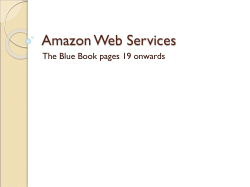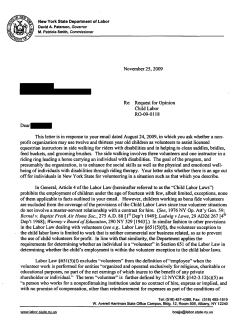
Getting started with online book selling (Part 1 of 2)
Focus on Friends Getting started with online book selling (Part 1 of 2) Find the right volunteers. BY MARSHA BENNETT Community Relations Manager, Johnson County (Kan.) Library; in cooperation with Matt Delaney, Internet Sales Supervisor, Friends of the Johnson County Library The Friends of the Johnson County (Kan.) Library (JCL) has been involved with online book selling since 2004, after hearing about the successes of other Friends groups at a Nuts & Bolts session at an ALA Annual Conference. This Friends group started out small, but has grown the online portion of their used book operations into a strong moneymaker that accounts for more than a third of their revenue. In this article, the Friends of JCL shares some ideas for Friends groups who are considering online sales as part of their revenue stream. A followup article will appear in the March/ April issue of The Voice, which will deal with growing online sales for those who are already selling online but may not have reached their full potential. Used book sales have been the mainstay of local Friends of the Library fundraisers for years. Many Friends groups have opened used book stores to expand book selling to a year-round venture. And some brave Friends groups have crossed over to the global marketplace by selling books online. Start small. Any Friends group, no matter its size, can sell online. All it takes is a person or volunteer with some time, a little book knowledge, and a computer. You can’t tell the value of a book by its cover. Books that are thought to be valuable should be set aside from those going to book sales. These items can be looked up online through various sites by the ISBN (International Standard Book Number) to determine their value. You can set your prices a bit lower than what you find online. Develop a philosophy of your threshold for listing a book online; it could be $10 or $20 or higher depending on your resources and how many items you can list and manage. Do your homework. Friends groups are beginning to realize there is more value in some books than the 50 cents or a dollar that a used book sale might generate. Or that the person who might be interested in a specific item may not live in the local community or walk into a Friends used book store. So what is the best way to test the waters and see if selling online is right for your Friends organization? What are the considerations for starting an online book sale business? When is the best time to begin? What sells best? Look at some of the online booksellers (Amazon, AbeBooks, even eBay.) You will find that nonfiction library weeds, textbooks and some contemporary fiction may command a higher price than bestsellers that can go for just a few cents. People are often looking for that one special book tied to their hobby, geographic location, favorite author, or special interest. It may not be a really old book or a recently released new book that brings in the most money. What you are looking for is a book that has a higher Amazon bestsellers rank; for example, a rank of 600 is better than 6 million. 12 www.ala.org/united Why sell online? 1-800-545-2433, ext. 2161 Do you know of someone who loves books and is computer savvy? This person is a good candidate to help get your online sales off the ground. The person you select will need to be able to enter a title or ISBN number and accurately describe the quality of the books or audiovisual materials you would like to sell. The general description of the item is most likely already on the site. People really enjoy the prospect of volunteering in this capacity. This function is great for those who have computer skills and recently retired, and it can also bring younger volunteers to your organization. Check with your local community volunteer centers or recruit in your newsletter for the skillset for these tasks. Acquire equipment. Your Friends group may need to purchase a computer or volunteers can use their home computers. You may be able to acquire used equipment from the library or through organizations that provide computers to nonprofit organizations. Some of your members may be upgrading their computer equipment and would consider donating computers to you for this purpose. Or, you could use some of your book sale funds for this type of purchase. You will also need some type of shelving to house the books and AV items you are listing. Develop a system. Start with a simple system. Each item you list online should have its own SKU (stock keeping unit) number. Develop a numbering system that is easy. You may want to assign each volunteer a range of numbers, such as John Doe 10,000-19,999; Mary Smith 20,000-29,999. Then each person listing assigns the SKU number as they list the item online. Use a 4 x 5 index card with the title and SKU number. Focus on Friends Inventory needs to be stored in a way that items can be easily located and retrieved. For example, place items for sale on a lettered shelf, A-1, A-2, A-3, B-1, B-2, etc. You do not need to follow the Dewey Decimal System. Keep track of where the SKU item is housed by adding its shelf location to the index card, which should be filed alphabetical by title. you may want to pull the item and sell it through other venues. Document what you are doing. Select a site for your listings. Set up an account with Amazon. com. It is the easiest for beginners. They have all the necessary information online and provide an easy sign up process. You will be asked for email and business address, business credit card, and bank account number. Amazon costs are usually 15% of the book selling price plus 99 cents per item. Postage of $2.99 or $3.99 per item is added, and your account will be credited with the postage cost. But it is up to you to mail the item and affix correct postage regardless of actual shipping costs. Start listing your items. Once your account is set up, search Amazon for the title you want to list. It will pull up the title. Make sure you have the correct edition and paperback or hardback designation. On the right side of the screen there is a button that says “Sell on Amazon.” Click on the button and fill in the information required. You will need to be able to describe the condition of the item you want to sell. What makes your item unique? If there is a dust jacket, specify that. Make sure you list any defects or library markings and rank the book such as used good, very good, etc. Then set a price for the item. In the beginning you may not want to select the check box for international shipping because of the high postage costs. If you have questions, you may contact Amazon’s customer service department through phone, email, or chat. Wait for the orders to come in. You will receive an email from Amazon when each order is received with a link to the order information and a place to click and print the order packing slip. You may purchase postage through Amazon or affix your own postage. Respond quickly to orders and try to mail them within one business day. Your reputation will be on the line with your customers, who can rank your level of service. Make sure to remove the listing from your index card inventory. You may want to make note of the selling price and customer name and address. Ship the orders. Using media mail, or library mail if you are attached to a library, is less expensive than first class mail. Your account has been credited for the postage, so look at the rates carefully as you mail items and determine the best ways to ship or mail. You will need to purchase or acquire mailing supplies — padded envelopes or small boxes, plus brown craft paper or bubble wrap to ship the orders. Volunteers may be recruited for this job of wrapping or boxing the order, taking it to the post office, and paying for the postage. Monitor your account. Check your account on a regular basis to make sure your prices are current. Prices can fluctuate due to demand or an increased number of the same title. You may no longer be the lowest priced seller and want to consider adjusting your price. Also, if a book has been listed for over a year, January/February 2013 Keep written notes on how you do things and your monthly sales totals. This is helpful to use as a training tool when you add more people to list items online. Develop written procedures for this aspect of your online used book operations. It is also fun to see where the orders come from and pinpoint them on a map. Share this information with your volunteers as positive feedback on the job they are doing. Online book selling does require an investment of time and resources, as well as committed volunteers and/ or Friends and library employees. But the rewards can be beneficial for your Friends group and the library you support. Your group of potential buyers for an item increases exponentially when you open the worldwide door. Now is a good time to start. Try on those online selling shoes and see how they fit. The Friends of the Johnson County Library has found internet sales to be growing while book sale and used book store revenues have flattened. The first year the Friends of JCL grossed $3,888.22 with 116 items sold. As of Oct. 31, 2012, Internet sales in 2012 totaled more than $120,000, with 5,649 items sold. The number of people involved has grown from one computer and one person to five computers and fifteen volunteers listing and shipping supervised by a part-time Friends employee. The second article in this series will appear in the March/April issue of The Voice, and will cover growing your internet sale business, using scanners, listing on multiple sites, mailing shortcuts, and inventory/order management systems. Those interested in online bookselling can find more information by logging into the Friends & Foundations Zone and accessing the two toolkits on online booksales. 13
© Copyright 2025





















